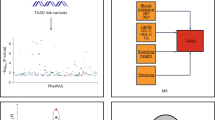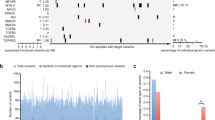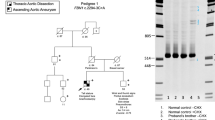Abstract
Thoracic aortic aneurysm and aortic dissection (TAA and AD) are an important cause of sudden death. Familial cases could account for 20% of all cases. A genetic heterogeneity with two identified genes (FBN1 and COL3A1) and three loci (3p24–25 or MFS2/TAAD2, 5q13–q14 and 11q23.2–24) has been shown previously. Study of a single family composed of 179 members with an abnormally high occurrence of TAA/AD disease. A total of 40 subjects from three generations were investigated. In addition to five cases of stroke and three cases of sudden death, there were four cases of AD and four cases of TAA in adults. In all, 11 cases of patent ductus arteriosus (PDA) were observed, two of which were associated with TAA and one with AD. Segregation analysis showed that the distribution of these vascular abnormalities was more likely compatible with a single genetic defect with an autosomal dominant pattern of inheritance. There were no clinical signs of Marfan, Elhers–Danlos vascular type or Char syndromes. Genetic linkage analysis was performed for seven genes or loci implicated in familial TAA/AD disease (COL3A1, FBN1, 3p24–25 or MFS2/TAAD2, 5q13–q14 and 11q23.2–q24), Char syndrome (TFAP2B) or autosomal recessive PDA (12q24). Using different genetic models, linkage with these seven loci was excluded. Familial TAA/AD with PDA is likely to be a particular heritable vascular disorder, with an as yet undiscovered Mendelian genetic basis.
Similar content being viewed by others
Log in or create a free account to read this content
Gain free access to this article, as well as selected content from this journal and more on nature.com
or
References
Svensjo S, Bengtson H, Bergqvist D : Thoracic and thoracoabdominal aortic aneurysm and dissection: an investigation based on autopsy. Br J Surg 1996; 83: 68–71.
Meszaros I, Morocz J, Szlavi J, Tornoci L, Nagy L, Szep L : Epidemiology and clinicopathology of aortic dissection. Chest 2000; 117: 1271–1278.
Coady MA, Davies RR, Roberts M et al: Familial patterns of thoracic aortic aneurysms. Arch Surg 1999; 134: 361–367.
Beighton P, De Paepe A, Steinmann B, Tsipouras P, Wenstrup RJ : Ehlers–Danlos syndromes: revised nosology, Villefranche, 1997. Am J Med Genet 1998; 77: 31–37.
Kontusaari S, Kuivaniami H, Tromp G, Grimwood R, Prockop DJ : A single base mutation in type III procollagen that converts the codon for glycine 619 to arginine in a family with aortic aneurysm. Ann NY Acad Sci 1990; 580: 556–557.
Kontusaari S, Tromp G, Kuivaniami H, Ladda RL, Prockop DJ : Inheritance of an RNA splicing mutation (G(+1) IVS20) in the type III procollagen gene (COL3A1) in a family having aortic aneurysms and easy bruisability: phenotypic overlap between familial arterial aneurysm and Ehlers–Danlos syndrome type IV. Am J Hum Genet 1990; 47: 112–120.
Francke U, Berg MA, Tynan K et al: A Gly1127Ser mutation in an EGF-like domain of the fibrillin-gene is a risk factor for ascending aortic aneurysm and dissection. Am J Hum Genet 1995; 56: 1287–1296.
Milewicz DM, Michael K, Fisher N, Coselli JS, Markello T, Biddinger A : Fibrillin-1 (FBN1) mutations in patients with thoracic aortic aneurysms. Circulation 1996; 94: 2708–2711.
Guo D, Hasham S, Kuang SQ et al: Familial thoracic aortic aneurysms and dissections: genetic heterogeneity with a major locus mapping to 5q13–14. Circulation 2001; 103: 2461–2468.
Vaughan CJ, Casey M, He J et al: Identification of a chromosome 11q23.2–q24 locus for familial aortic aneurysm disease, a genetically heterogeneous disorder. Circulation 2001; 103: 2469–2475.
Hasham SN, Willing MC, Guo DC et al: Mapping a locus for Familial Thoracic Aortic Aneurysms and Dissection (TAAD2) to 3p24–25. Circulation 2003; 107: 3184–3190.
Collod G, Babron MC, Jondeau G et al: A second locus for Marfan syndrome maps to chromosome 3p24.2–p25. Nat Genet 1994; 8: 264–268.
Glancy DL, Wegmann M, Dhurandhar RW : Aortic dissection and patent ductus arteriosus in three generations. Am J Cardiol 2001; 87: 813–815.
Roman MJ, Devereux RB, Kramer-Fox R, O'Loughlin J : Two-dimensional echocardiographic aortic root dimension in normal children and adults. Am J Cardiol 1989; 64: 507–512.
Higgins CB : The vascular system. In Higgins CB, Hricak H, Helms CA (eds): Magnetic resonance imaging of the body. New York: Lippincott-Raven, 1987, pp 309–346.
Cohen GI, White M, Shochowski RA et al: Reference values for normal adult transesophageal echocardiographic measurements. J Am Soc Echocardiogr 1995; 8: 221–230.
Bonney GE : Regressive logistic models for familial disease and other binary traits. Biometrics 1986; 42: 611–625.
Demenais F, Lathrop M : REGRESS: a computer program including the regressive approach into the LINKAGE package. Genet Epidemiol 1994; 11: 291.
Elston RC, Stewart J : A general model for the genetic analysis of pedigree data. Hum Hered 1971; 21: 523–542.
Sambrook J, Fritsch EF, Maniatis T : Molecular cloning: a laboratory manual. New York: Cold Spring Harbor Laboratory; 1989.
Milewicz DM, Chen H, Park ES et al: Reduced penetrance and variable expressivity of familial thoracic aortic aneurysms/dissections. Am J Cardiol 1998; 82: 474–479.
Vaughan CJ, Basson CT : Molecular determinants of atrial and ventricular septal defects and patent ductus arteriosus. Am J Med Genet (Semin Med Genet) 2001; 97: 304–309.
Lathrop GM, Lalouel JM, Julier C, Ott J : Strategies for multilocus linkage analysis in humans. Proc Natl Acad Sci USA 1984; 81: 3443–3446.
Satoda M, Zhao F, Diaz GA et al: Mutations in TFAP2B cause Char syndrome, a familial form of patent ductus arteriosus. Nat Genet 2000; 25: 42–46.
Teien D, Finley JP, Murphy DA, Lacson A, Longhi J, Gillis DA : Idiopathic dilatation of the aorta with dissection in a family without Marfan syndrome. Acta Paediatr Scand 1991; 80: 1246–1249.
Clyman RI : Developmental physiology of the ductus arteriosus. in Brand M (ed): Fetal and neonatal cardiology. New York: Lippincott-Raven, 1997, pp 64–75.
Smith GCS : The pharmacology of the ductus arteriosus. Pharmacol Rev 1998; 50: 35–58.
Gelb BD, Zhang J, Sommer RJ, Wasserman JM, Reitman MJ, Willner JP : Familial patent ductus arteriosus and bicuspid aortic valve with hand anomalies: a novel heart–hand syndrome. Am J Med Genet 1999; 87: 175–179.
Larson EW, Edwards WD : Risk factors for aortic dissection: a necropsy study of 161 cases. Am J Cardiol 1984; 53: 849–855.
Epperlein S, Mohr-Kahaly S, Erbel R, Kearney P, Meyer J : Aorta and aortic valve morphologies predisposing to aortic dissection. An in vivo assessment with transoesophageal echocardiography. Eur Heart J 1994; 15: 1520–1527.
Zhao F, Weismann CG, Satoda M et al: Novel TFAP2B mutations that cause Char syndrome provide a genotype–phenotype correlation. Am J Hum Genet 2001; 69: 695–703.
Mani A, Meraji SM, Houshyar R et al: Finding genetic contributions to sporadic disease: a recessive locus at 12q24 commonly contributes to patent ductus arteriosus. Proc Natl Acad Sci USA 2002; 99: 15054–15059.
Digilio MC, Marino B, Picchio F et al: Noonan syndrome and aortic coarctation. Am J Med Genet 1998; 80: 160–162.
Mays PK, Tromp G, Kuivaniemi H, Ryynanen M, Prockop DJ : A 15 base-pair AT-rich variable number tandem repeat in the type III procollagen gene (COL3A1) as an informative marker for 2q31–2q32.3. Matrix 1992; 12: 44–49.
Weissenbach J, Gyapay G, Dib C et al: A second-generation linkage map of the Human genome. Nature 1992; 359: 794–801.
Pereira L, Levran O, Ramirez F et al: A molecular approach to the stratification of cardiovascular risk in families with Marfan's syndrome. N Engl J Med 1994; 331: 148–153.
Brzustowicz LM, Kleyn PW, Boyce FM et al: Fine-mapping of the spinal muscular atrophy locus to a region flanked by MAP1B and D5S6. Genomics 1992; 13: 991–998.
Acknowledgements
We thank first the members of the ‘Bourgogne family’ for participating in this study and INSERM, the Fondation pour la Recherche Médicale, the Association de Cardiologie de Bourgogne and the Association Claude Bernard for their financial support as well as Nathalie Khau Van Kien, Dr Caroline Bulté, Dr Annie Petit, Dr Elisabeth Devilliers, Dr Marie-Thérèse Zabot, Pr Michel David and Pr Pierre Corvol for their contribution to the study.
Author information
Authors and Affiliations
Corresponding author
Rights and permissions
About this article
Cite this article
Khau Van Kien, P., Wolf, JE., Mathieu, F. et al. Familial thoracic aortic aneurysm/dissection with patent ductus arteriosus: genetic arguments for a particular pathophysiological entity. Eur J Hum Genet 12, 173–180 (2004). https://doi.org/10.1038/sj.ejhg.5201119
Received:
Revised:
Accepted:
Published:
Issue date:
DOI: https://doi.org/10.1038/sj.ejhg.5201119
Keywords
This article is cited by
-
A targeted sequencing approach to find novel pathogenic genes associated with sporadic aortic dissection
Science China Life Sciences (2018)
-
Variants of genes encoding collagens and matrix metalloproteinase system increased the risk of aortic dissection
Science China Life Sciences (2017)
-
Dissecting Thoracoabdominal Aortic Aneurysm in a 15-Year-Old Boy With Polycystic Kidney Disease and Other Risk Factors
Pediatric Cardiology (2012)
-
Epidemiology of thoracic aortic dissection
Nature Reviews Cardiology (2011)
-
Patent arterial duct
Orphanet Journal of Rare Diseases (2009)



